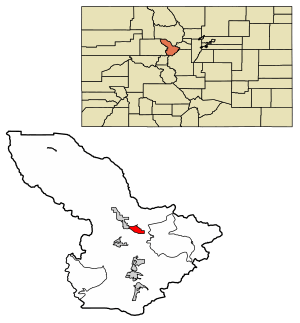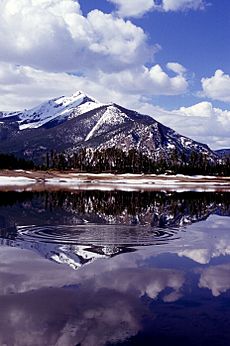Dillon, Colorado facts for kids
Quick facts for kids
Dillon, Colorado
|
|
|---|---|
| Town of Dillon | |

Dillon, Colorado
|
|

Location of the Town of Dillon in Summit County, Colorado.
|
|
| Country | |
| State | |
| County | Summit |
| Incorporated | January 26, 1883 |
| Government | |
| • Type | Home rule municipality |
| Area | |
| • Total | 2.324 sq mi (6.018 km2) |
| • Land | 1.494 sq mi (3.869 km2) |
| • Water | 0.830 sq mi (2.149 km2) |
| Elevation | 9,019 ft (2,749 m) |
| Population
(2020)
|
|
| • Total | 1,064 |
| • Density | 712/sq mi (275/km2) |
| • Metro | 31,055 |
| Time zone | UTC−07:00 (MST) |
| • Summer (DST) | UTC−06:00 (MDT) |
| ZIP code |
80435
|
| Area code(s) | 970 |
| FIPS code | 08-20440 |
| GNIS feature ID | 2412431 |
The Town of Dillon is a small town in Summit County, Colorado, United States. It's a special kind of town called a home rule municipality, which means it has more control over its own local laws. In 2020, about 1,064 people lived there. This was a good increase from 2010, showing more people are choosing to live in Dillon!
Contents
History of Dillon
The first town of Dillon started as a place for travelers to stop and trade goods. It was on the northeast side of the Snake River. The town got its name from Tom Dillon, who was a prospector (someone who searches for valuable minerals). Dillon officially became a town in 1883.
Moving the Town
By 1892, the town had to move two times! Each time, it moved to be closer to the new railroad lines that were being built. All three of these old town locations were very close to where the Snake River and Tenmile Creek joined the Blue River Valley. Today, people call this area "Old Dillon."
Building the Reservoir
Later, during the Great Depression, a company called Denver Water started buying land around Dillon. In 1956, the people and businesses in Dillon got news that they needed to sell their properties and move. Denver Water was going to build a big dam nearby. This dam would create a huge lake, called a reservoir, which would flood the old town of Dillon and the valley around it. This reservoir would help provide water to many communities in the Front Range area.
So, the town of Dillon moved again! The new town was built about a mile north and 160 feet higher up on a hillside. This new location is now right on the edge of the beautiful Dillon Reservoir.
Geography of Dillon
In 2020, the town of Dillon covered about 6.018 square kilometers (about 2.3 square miles). A big part of this area, about 2.149 square kilometers (0.8 square miles), is water from the reservoir. The Dillon Dam and its reservoir, also known as Lake Dillon, are right next to the town. The Continental Divide, which is like a giant mountain ridge that separates rivers flowing to different oceans, is only about 10 miles to the east.
Dillon's Climate
Dillon has a special kind of cold climate called an alpine subarctic climate. This means it gets very cold and snowy winters.
- Summer: Days are usually warm, but nights can get quite chilly, sometimes even close to freezing.
- Winter: Days are cold, and there's a lot of snow!
| Climate data for Dillon, Colorado, 1991–2020 normals, extremes 1910–present | |||||||||||||
|---|---|---|---|---|---|---|---|---|---|---|---|---|---|
| Month | Jan | Feb | Mar | Apr | May | Jun | Jul | Aug | Sep | Oct | Nov | Dec | Year |
| Record high °F (°C) | 61 (16) |
60 (16) |
63 (17) |
76 (24) |
80 (27) |
87 (31) |
89 (32) |
87 (31) |
84 (29) |
77 (25) |
65 (18) |
61 (16) |
89 (32) |
| Mean maximum °F (°C) | 46.3 (7.9) |
48.4 (9.1) |
55.3 (12.9) |
62.9 (17.2) |
71.1 (21.7) |
78.9 (26.1) |
82.2 (27.9) |
80.0 (26.7) |
76.1 (24.5) |
69.0 (20.6) |
57.7 (14.3) |
48.5 (9.2) |
82.5 (28.1) |
| Mean daily maximum °F (°C) | 31.1 (−0.5) |
33.4 (0.8) |
40.5 (4.7) |
47.5 (8.6) |
57.6 (14.2) |
69.1 (20.6) |
75.0 (23.9) |
72.5 (22.5) |
66.2 (19.0) |
54.1 (12.3) |
41.1 (5.1) |
31.7 (−0.2) |
51.7 (10.9) |
| Daily mean °F (°C) | 16.3 (−8.7) |
18.5 (−7.5) |
25.5 (−3.6) |
32.8 (0.4) |
41.8 (5.4) |
50.8 (10.4) |
56.6 (13.7) |
54.7 (12.6) |
47.9 (8.8) |
37.4 (3.0) |
26.2 (−3.2) |
17.3 (−8.2) |
35.5 (1.9) |
| Mean daily minimum °F (°C) | 1.5 (−16.9) |
3.6 (−15.8) |
10.5 (−11.9) |
18.1 (−7.7) |
25.9 (−3.4) |
32.6 (0.3) |
38.1 (3.4) |
36.9 (2.7) |
29.7 (−1.3) |
20.7 (−6.3) |
11.4 (−11.4) |
3.0 (−16.1) |
19.3 (−7.0) |
| Mean minimum °F (°C) | −15.5 (−26.4) |
−14.5 (−25.8) |
−7.2 (−21.8) |
3.8 (−15.7) |
15.2 (−9.3) |
25.0 (−3.9) |
31.7 (−0.2) |
31.0 (−0.6) |
20.4 (−6.4) |
5.9 (−14.5) |
−7.7 (−22.1) |
−14.5 (−25.8) |
−19.2 (−28.4) |
| Record low °F (°C) | −44 (−42) |
−45 (−43) |
−38 (−39) |
−25 (−32) |
−8 (−22) |
11 (−12) |
22 (−6) |
20 (−7) |
4 (−16) |
−17 (−27) |
−30 (−34) |
−46 (−43) |
−46 (−43) |
| Average precipitation inches (mm) | 0.95 (24) |
0.99 (25) |
1.15 (29) |
1.42 (36) |
1.34 (34) |
1.13 (29) |
1.87 (47) |
1.91 (49) |
1.40 (36) |
0.98 (25) |
0.88 (22) |
0.87 (22) |
14.89 (378) |
| Average snowfall inches (cm) | 18.0 (46) |
17.0 (43) |
17.5 (44) |
17.3 (44) |
6.4 (16) |
0.7 (1.8) |
0.0 (0.0) |
0.0 (0.0) |
1.1 (2.8) |
7.1 (18) |
14.6 (37) |
15.8 (40) |
115.5 (292.6) |
| Average precipitation days (≥ 0.01 in) | 11.7 | 11.3 | 11.3 | 11.3 | 9.6 | 8.3 | 11.9 | 13.5 | 9.9 | 8.1 | 9.5 | 10.9 | 127.3 |
| Average snowy days (≥ 0.1 in) | 9.7 | 9.6 | 9.4 | 8.8 | 3.0 | 0.4 | 0.0 | 0.0 | 0.5 | 3.7 | 8.0 | 9.1 | 62.2 |
| Source 1: NOAA | |||||||||||||
| Source 2: National Weather Service | |||||||||||||

Dillon's Population
The number of people living in Dillon has changed over the years. Here's how the population has grown:
| Historical population | |||
|---|---|---|---|
| Census | Pop. | %± | |
| 1890 | 133 | — | |
| 1900 | 143 | 7.5% | |
| 1910 | 134 | −6.3% | |
| 1920 | 126 | −6.0% | |
| 1930 | 92 | −27.0% | |
| 1940 | 161 | 75.0% | |
| 1950 | 191 | 18.6% | |
| 1960 | 814 | 326.2% | |
| 1970 | 182 | −77.6% | |
| 1980 | 337 | 85.2% | |
| 1990 | 553 | 64.1% | |
| 2000 | 802 | 45.0% | |
| 2010 | 904 | 12.7% | |
| 2020 | 1,064 | 17.7% | |
| U.S. Decennial Census | |||
In 2000, there were 802 people living in Dillon. These people lived in 369 households, and 195 of those were families. The town had many homes, with about 1,280 housing units.
Most people in Dillon were White (about 95.64%). A smaller number of people were African American, Native American, or Asian. About 10.35% of the population identified as Hispanic or Latino.
About 21.4% of households had children under 18. Many households (42.5%) were married couples. The average household had about 2.17 people.
The median age in Dillon was 37 years old. This means half the people were younger than 37, and half were older. About 15.5% of the population was under 18, and 9.0% were 65 or older.

Famous People from Dillon
Here are some notable people who have lived in or were born in Dillon:
- Richard F. Bansemer: A Lutheran pastor.
- Frederic J. Brown III: A U.S. Army lieutenant general.
- Millie Hamner: A politician who served in the Colorado state legislature.
- Enid Markey (1894–1981): An actress.
- Julie McCluskie: A member of the Colorado House of Representatives.
- Duane D. Pearsall (1922–2010): An inventor and business owner known for smoke detectors.
- Christine Scanlan: Another politician who served in the Colorado state legislature.
See also
 In Spanish: Dillon (Colorado) para niños
In Spanish: Dillon (Colorado) para niños


